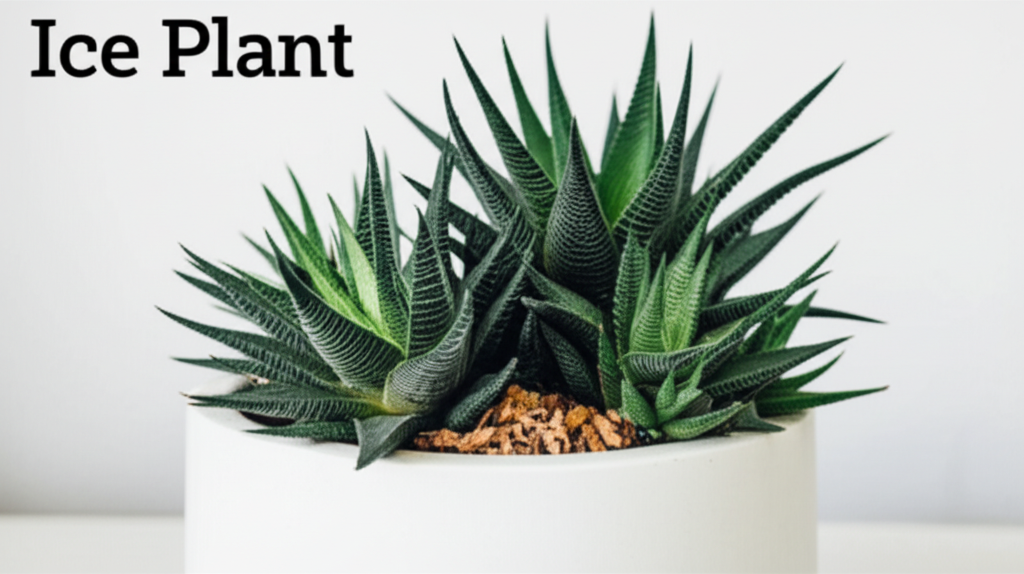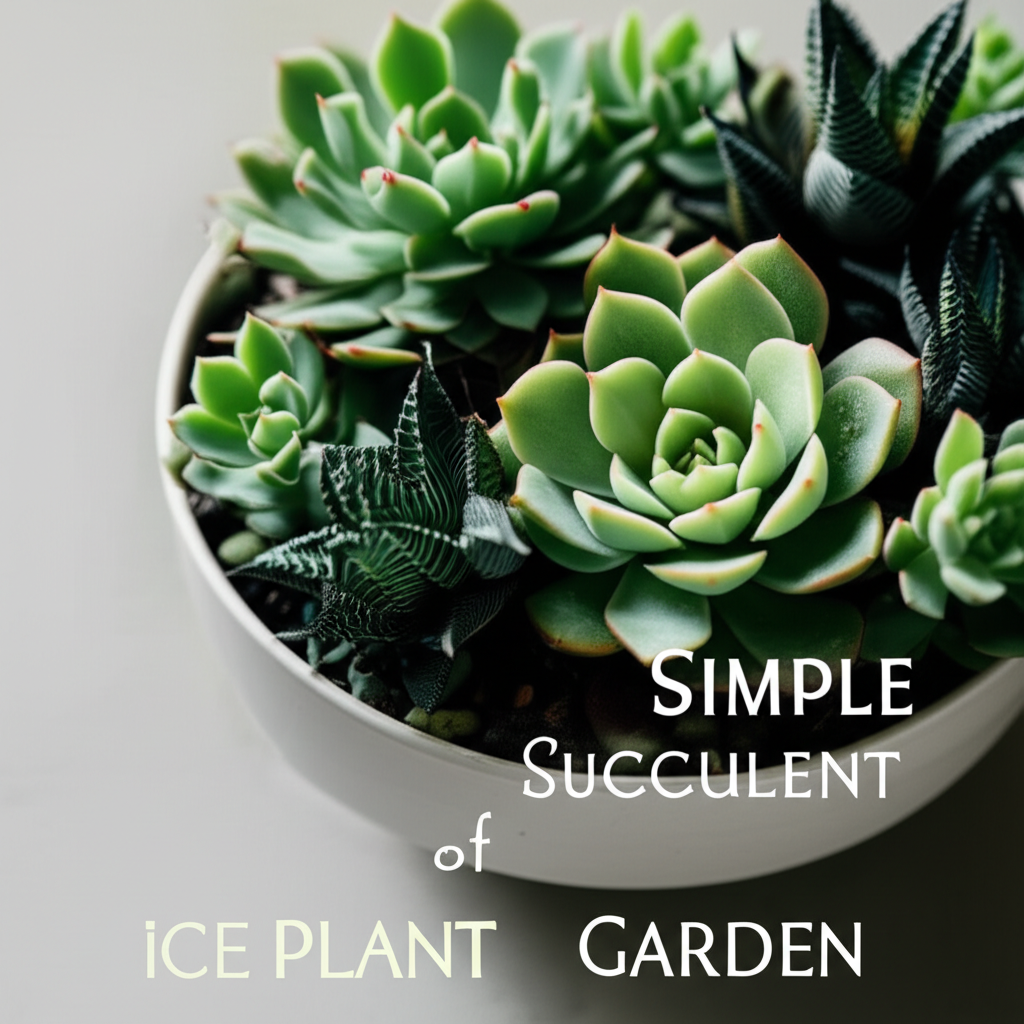Ice plants (Delosperma) are a gardener’s delight. These resilient succulents, known for their vibrant, daisy-like flowers and fleshy, jewel-like leaves, offer a stunning visual impact with minimal fuss. Whether you’re a seasoned horticulturist or just starting your gardening journey, incorporating ice plants into your landscape can transform ordinary spaces into captivating displays. This guide will delve into simple, effective arrangement tips to help you create breathtaking ice plant succulent gardens.
Understanding Ice Plants: The Foundation of Your Arrangement
Before diving into arrangement techniques, it’s crucial to understand the unique characteristics of ice plants that make them so amenable to creative garden design.
Key Characteristics:
- Drought Tolerance: Ice plants thrive in arid conditions, making them perfect for water-wise gardening.
- Sun-Loving: They require at least 6-8 hours of direct sunlight daily to produce their abundant blooms.
- Well-Draining Soil: This is paramount. Poorly drained soil can lead to root rot.
- Low Maintenance: Generally pest and disease resistant, requiring little more than occasional watering and deadheading.
- Mat-forming Habit: Many varieties spread horizontally, creating a living carpet of color.
- Varied Bloom Times: Different species and cultivars offer blooms from spring through fall.
Popular Ice Plant Varieties for Arrangements:
Choosing the right varieties is key to a cohesive and visually appealing arrangement. Consider their mature size, color, and bloom time.
- ‘Jewel of Desert’ Series: Known for its exceptionally large and vibrant flowers in a wide spectrum of colors like pink, orange, red, and yellow. They have a compact, mounding habit.
- ‘Sundance’: A classic with bright yellow flowers and a spreading habit, excellent for covering ground.
- ‘Coral Carpet’: Features coral-pink flowers and silvery-green foliage, forming a dense mat.
- ‘Purple Ice’: Offers stunning magenta-purple blooms and a vigorous spreading growth.
- ‘White Delight’: A delicate variety with pure white flowers, providing a lovely contrast.
Essential Elements for a Successful Ice Plant Arrangement

Creating a beautiful arrangement involves more than just placing plants. Understanding the fundamental elements will guide your design process.
Site Selection: The Crucial First Step
The success of your ice plant garden hinges on choosing the right location.
- Sunlight: As mentioned, ample sunlight is non-negotiable. Look for areas that receive full sun for the majority of the day.
- Drainage: This cannot be stressed enough. Avoid low-lying areas where water tends to collect. Sloping sites, raised beds, or areas with sandy or gritty soil are ideal.
- Wind Exposure: While ice plants are generally hardy, consider protecting them from excessively strong winds, especially in their first year.
- Foot Traffic: If you’re planting in a pathway or border, ensure the chosen spot can withstand some foot traffic if necessary, opting for more robust varieties.
Soil Preparation: The Foundation of Health
Proper soil preparation is vital for the longevity and vibrant growth of your ice plants.
- Amendments: If your native soil is heavy clay, incorporate coarse sand, gravel, or perlite to improve drainage. A well-draining potting mix designed for succulents or cacti is also an excellent option.
- pH Level: Ice plants prefer slightly acidic to neutral soil (pH 6.0-7.0).
- Fertilizer: They are not heavy feeders. A light application of a balanced, slow-release fertilizer in the spring is usually sufficient. Over-fertilizing can lead to leggy growth and fewer blooms.
Companion Planting: Enhancing the Arrangement
While ice plants are stunning on their own, strategic companion planting can elevate your garden’s visual appeal and biodiversity.
- Drought-Tolerant Companions: Pair ice plants with other succulents and low-water plants that share similar growing conditions. Consider Sedums, Sempervivums (Hens and Chicks), Echeverias, and other groundcover succulents.
- Textural Contrast: Introduce plants with different leaf textures. Fine-textured ornamental grasses or plants with spiky foliage can create a dynamic interplay.
- Color Harmony: Complement the vibrant colors of ice plants with plants that offer contrasting or harmonious hues. Silver foliage plants, blues, and purples can be particularly striking.
- Pollinator Attractors: Many ice plant varieties are magnets for bees and butterflies. Consider other pollinator-friendly plants like Lavender, Rosemary, or Coneflowers to further enhance your garden’s ecosystem.
Creative Arrangement Techniques for Ice Plants
Now, let’s explore practical techniques to arrange your ice plants for maximum visual impact.
The “Carpet of Color” Approach
This is perhaps the most popular and effective way to use ice plants. Their spreading habit makes them ideal for groundcover.
- Coverage: Plant ice plants relatively close together (spacing according to mature size) to encourage them to knit together and form a dense mat. This suppresses weeds and creates a unified visual statement.
- Pathways and Borders: Use them to edge garden beds, spill over retaining walls, or fill in gaps between larger plants.
- Rock Gardens: Their ability to thrive in rocky, well-drained environments makes them perfect for rock garden designs.
Container Gardening with Ice Plants
Ice plants are equally spectacular in containers, bringing color and texture to patios, balconies, and entryways.
- Drainage is Key: Ensure your containers have adequate drainage holes. Terra cotta pots are excellent as they allow soil to breathe and dry out faster.
- Mixed Containers: Combine ice plants with other drought-tolerant succulents, ornamental grasses, or even a contrasting upright succulent for height.
- Hanging Baskets: Trailing varieties of ice plants can create a cascade of color in hanging baskets.
- Watering: Containers dry out more quickly than garden beds, so monitor moisture levels closely.
Rockeries and Alpine Gardens
The natural habitat of many ice plant species lends itself to rock garden designs.
- Interspersed with Rocks: Place ice plants amongst rocks, allowing their fleshy leaves and vibrant blooms to soften the hardscape.
- Sloping Sites: They perform exceptionally well on slopes, where drainage is naturally enhanced.
- Mimicking Natural Environments: Use gravel, sand, and small stones to create a xeriscape look that mimics their native rocky environments.
Vertical Gardening and Green Walls
For those with limited horizontal space, ice plants can be incorporated into vertical gardening projects.
- Specialized Systems: Use pockets or modules designed for succulents in vertical garden structures.
- Regular Watering: Vertical gardens tend to dry out very quickly, so consistent watering will be crucial.
- Variety Selection: Opt for more compact and trailing varieties for best results.
Key Facts and Comparison of Arrangement Styles
To help you visualize the possibilities, let’s compare different arrangement styles.
| Arrangement Style | Ideal For | Key Benefits | Considerations | Visual Impact |
|---|---|---|---|---|
| Groundcover/Carpet | Large areas, borders, pathways | Weed suppression, vibrant visual flow | Requires mass planting, can take time to establish | Continuous bloom, unifying effect |
| Container Gardening | Patios, balconies, small spaces | Portability, controlled environment, focal points | Requires regular watering, soil amendments | Concentrated bursts of color, adaptability |
| Rock Gardens | Sloping sites, arid landscapes, naturalistic designs | Excellent drainage, natural aesthetic, low maintenance | Requires specific soil conditions, plant selection is critical | Textural contrast, integration with hardscape |
| Vertical Gardening | Limited horizontal space, modern designs | Space-saving, unique visual interest | High watering needs, specific plant requirements | Striking architectural element, cascading effect |
Step-by-Step Guide and Pros/Cons
Here’s a breakdown of the general steps involved in creating an ice plant arrangement, along with their advantages and disadvantages.
| Step | Description | Pros | Cons |
|---|---|---|---|
| 1. Site Selection & Preparation | Choose a sunny location with excellent drainage. Amend soil with sand or grit if necessary. | Ensures plant health and optimal flowering. Minimizes risk of root rot. | Requires careful assessment of existing conditions. |
| 2. Plant Selection | Choose varieties based on desired color, size, and growth habit. Consider companion plants. | Creates a cohesive and visually appealing design. Enhances biodiversity. | Requires research into different ice plant varieties. |
| 3. Planting | Dig holes slightly larger than the root ball. Plant at the same depth as the nursery pot. Space according to mature size. | Promotes healthy root establishment. Prevents overcrowding. | Initial labor intensive for large areas. |
| 4. Watering | Water thoroughly after planting. Allow soil to dry out completely between waterings. Reduce watering in winter. | Encourages deep root growth. Prevents overwatering issues. | Requires learning the plant’s specific watering needs. |
| 5. Mulching (Optional) | Apply a layer of gravel or small stones around the plants. | Helps retain moisture, suppress weeds, and keep plant crowns dry. | Can sometimes inhibit spreading in certain configurations. |
| 6. Ongoing Care | Deadhead spent blooms to encourage further flowering. Trim back any overgrown or straggly stems. | Maintains plant appearance and promotes continuous bloom. | Minimal, but regular observation is beneficial. |
Tips for Maintaining Your Ice Plant Garden
Once established, ice plant gardens are remarkably easy to care for.
- Watering Wisdom: The most common mistake is overwatering. Only water when the soil is completely dry to the touch. In regions with regular rainfall, you may not need to water them at all during the growing season.
- Pruning and Deadheading: While not strictly necessary for survival, deadheading spent flowers can encourage more blooms and keep the plants looking tidy. You can also trim back leggy growth in early spring to promote bushier plants.
- Pest and Disease Management: Ice plants are generally pest and disease-free. If you do encounter issues like mealybugs, a gentle stream of water or insecticidal soap can usually resolve the problem. Ensure good air circulation.
- Overwintering: In colder climates (below USDA Zone 4 or 5, depending on the variety), ice plants may need protection or to be treated as annuals. Container-grown plants can be moved to a cool, dry, and frost-free location for the winter.
Troubleshooting Common Issues
Even the most resilient plants can encounter occasional problems.
- Leggy Growth: This is usually a sign of insufficient sunlight. Move the plant to a sunnier location or thin out the foliage to improve air circulation.
- No Blooms: Lack of sunlight is the most common cause. Ensure the plants are receiving at least 6-8 hours of direct sun. Over-fertilizing can also inhibit flowering.
- Rotting: This is almost always due to overwatering or poor drainage. Improve drainage by amending the soil or repotting in a better-draining mix.
Conclusion: Embracing the Beauty of Ice Plant Arrangements
Ice plants offer an unparalleled combination of vibrant color, low maintenance, and drought tolerance. By understanding their needs and employing simple yet effective arrangement techniques, you can create captivating succulent gardens that bring joy and beauty to your outdoor spaces. Whether you’re aiming for a dazzling carpet of color, a charming container display, or a naturalistic rock garden, ice plants are a versatile and rewarding choice for any gardener. Embrace experimentation, enjoy the process, and let the sun-kissed blooms of your ice plant arrangements brighten your world.


